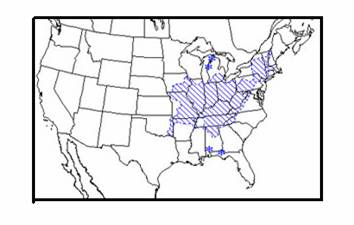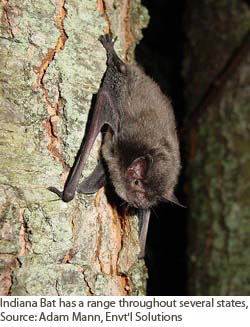Indiana Bat (Myotis sodalis)
SYSTEMATICS:
The Indiana Bat got its common name from the type specimen that was first found in the Wyandotte Cave in Indiana in 1904. They belong to the order Chiroptera and the family Vespertilionidae. Members of this species are one of many in the genus Myotis, which means “mouse ear”, and is used to describe their small mouse-like ears. The Indiana Bat closely resembles the little brown bat (Myotis lucifugus), but differs in its greyish brown coloration instead of bronze. Biologists can distinguish this species from other bats by their feet, which are smaller and more delicate that their relatives with a distinctive keeled calcar. A keeled calcar is a foot spur composed of cartilage that supports the membrane between the foot and tail. The presence of fewer shorter hairs on the hind feet and its pink lips are also distinguishing characteristics of the Indiana Bat (Engel, James 1976)
The species richness of the Indiana Bat has declined over the years. The most recent estimate of the total populations of Indiana Bats in the U.S. was about 457,000 individuals and was done in 2005. This population estimate is half the amount that was present when the species was listed as endangered in 1967. Studies in 1985 have estimated the total known past population of Indiana Bats in Pennsylvania to be around 5,000. The most recent count in 2007 showed a great decrease in species richness with only 774 individuals in Pennsylvania. (Steele, et al. 2010)
ECOLOGY:
The Indiana Bat is found in most of the Eastern U.S. ranging from Oklahoma and Wisconsin, East to Vermont, and South to Florida. They are most commonly found hibernating in caves in Southern Indiana, where almost half of the population is located (207,000 in 2005). This species has been found to be more abundant in New York, Missouri, Kentucky and Illinois, all of which had populations greater than 40,000. 
The Indiana Bat hibernates from autumn to spring, and have both winter and summer habitats. Hibernacula consist of limestone caves and abandoned mine shafts, and have certain requirements for hibernation. This species requires cool, humid hibernation sites with temperatures that are cool but remain above freezing, averaging about 37-43° F in mid-winter. There are very few sites within the species range that have these conditions. M. sodalis hibernates in clusters, sometimes with other species such as the little brown bat and northern-long eared bats. 
In the summer, Indiana Bats generally roost in the trees of flood-plain and upland forests, and are usually found under the loose bark or in the cavities of dead or dying trees. Females occupy roost sites of up to 100 females, called maternity colonies, while males roost in smaller groups near the females. Maternity colonies must maintain a certain temperature, and for this reason females have a primary roost site and an alternate roost site. Primary roost sites are located in areas that contain a lot of sun such as openings or near the edge of forests, and alternate roosts sites can be located in forests interiors and have cooler temperatures. Some Indiana Bats have been found roosting in urban areas, such as in attics or garages. The Indiana Bat’s diet consists of flying insects such as moths and mosquitoes, and trees along streams or open bodies of water are common foraging areas. 
REPRODUCTION:
THREATS:
Indiana bats are listed as a federally endangered species, and are also listed as a Pennsylvania state endangered species. One of the main threats to this species is habitat disturbance, particularly during hibernation. Since this species hibernates in relatively large numbers, they are sensitive to disturbances such as human entry, which causes bats to wake up and use up stored energy that is required for survival during the winter. Loss of habitat has an effect on the foraging areas during the summer months, which can lead to less energy and stored fat when re-entering hibernation. Because of these common disturbances, many Indiana bats have adapted to man-made structures for their hibernation sites. Unnatural predators such as feral cats also pose as threats to Indiana bats. Another major threat to Indiana bats, as well as many other bats is White-Nose syndrome (WNS). WNS is an infectious fungal disease that emerged in 2006 and is responsible for high mortality rates in hibernating bats. The fungus invades the skin of hibernating bats, and grows on the nose, wings and ears. Invasion of the fungus affects the physiological processes of bats while in hibernation, and causes rare and potentially fatal behavior such as leaving hibernacula during the cold winter months. The most recent account of Indiana bats affected in Indiana revealed a 16% decline in species due to WNS in 3 winters (DNR 2014).
MANAGEMENT
The Indiana bat is a challenging animal to study due to its mobility and nocturnal habitats. This species is protected under the Federal Cave Resources Protection Act of 1988, and one of the most common management practices is the protection of hibernacula, which includes placing bat-friendly gates in front of caves where there are hibernating bat populations. More summer habitats including roosts, foraging areas and also migration routes need to be identified. Since summer roosts aren’t permanent, the use of artificial roosts has been considered and known maternity roosts should be protected. Continued research is needed, such as monitoring bat populations at known roosting sites and hibernacula. The US Fish and Wildlife Service continues to monitor their behavior, including their roost preferences and distribution through radio telemetry and mist netting projects (USFWS, 2006).
REFERENCES:
- "ITIS Standard Report Page: Vespertilionidae." ITIS Standard Report Page: Vespertilionidae. N.p., n.d. Web. 24 Apr. 2015. <http://www.itis.gov/servlet/SingleRpt/SingleRpt?search_topic=TSN&search_value=179986>.
- Steele, Michael, et al Terrestrial Vertebrates of Pennsylvania. 1st ed. N.p.: John Hopkins UP, 2010. Print.
- "Indiana Bat (Myotis Sodalis)." USFWS: Indiana Bat (Myotis Sodalis) Fact Sheet. N.p., Dec. 2006. Web. 24 Apr. 2015. <http://www.fws.gov/midwest/endangered/mammals/inba/inbafctsht.html>.
- "Indiana Bat." Wikipedia. Wikimedia Foundation, n.d. Web. 24 Apr. 2015. <http://en.wikipedia.org/wiki/Indiana_bat>.
- Engel, James M. The Indiana Bat, Myotis Sodalis. Washington, D.C.: G P O, 1976. Web. 24 Apr. 2015. <http://www.state.nj.us/dep/fgw/ensp/pdf/end-thrtened/indianabat.pdf>.
- "Indiana Department of Natural Resources." DNR: White-nose Syndrome in Bats. N.p., n.d. Web. 24 Apr. 2015. <http://www.in.gov/dnr/fishwild/5404.htm>.

No comments:
Post a Comment